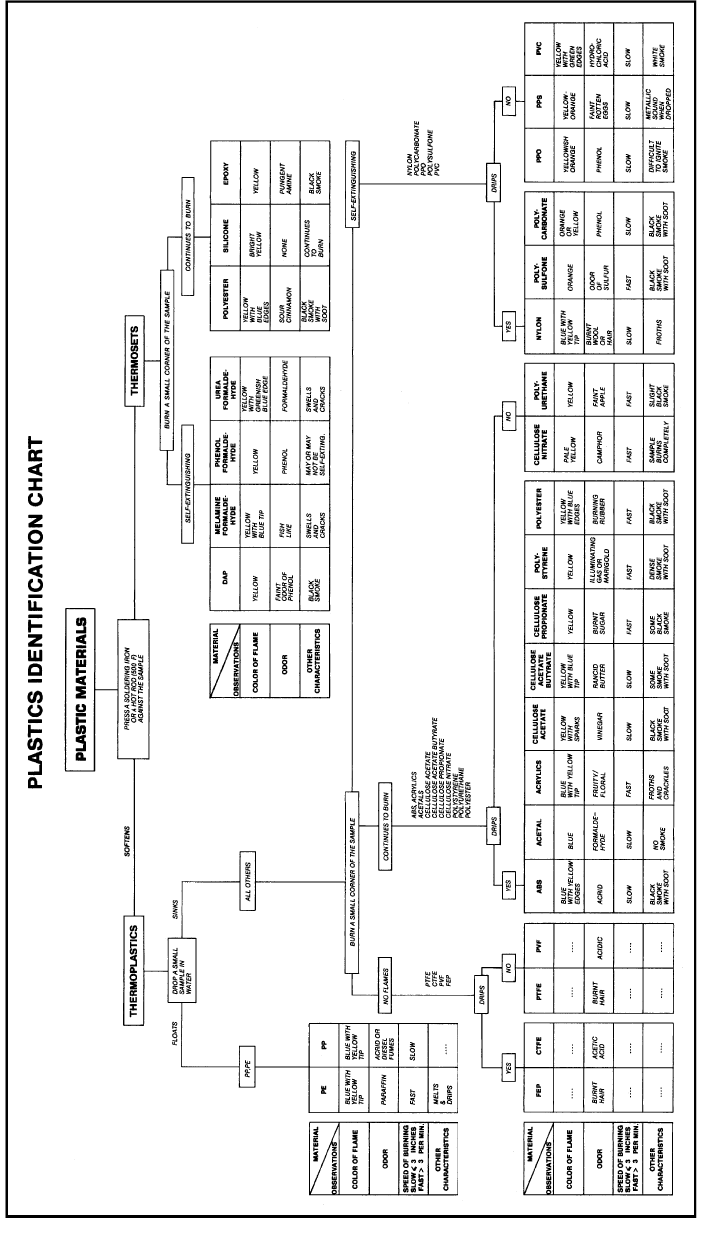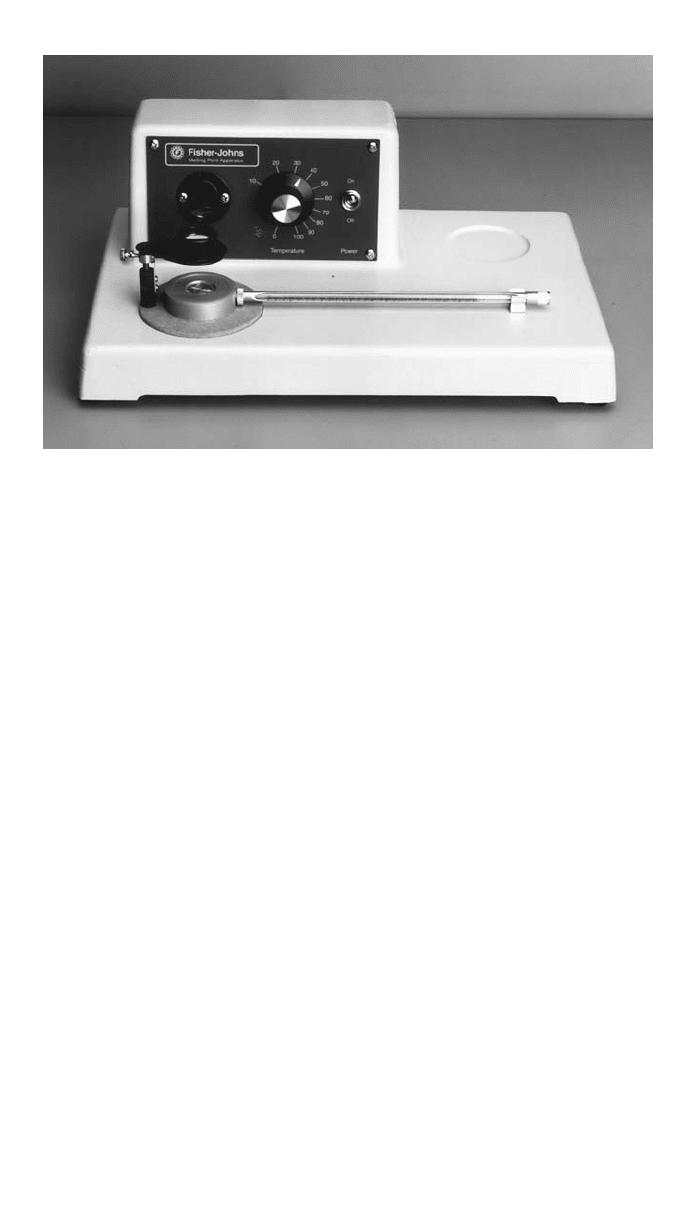Kutz M. Handbook of materials selection
Подождите немного. Документ загружается.


608 CHARACTERIZATION AND IDENTIFICATION OF PLASTICS
Fig. 11 Sample spectrometer layout. (Courtesy Nicolet Instruments)
in order to verify the material used during its manufacture. The custom com-
pounders of reprocessed materials may also need to identify already processed
material purchased from different sources. Quite often, processors find substan-
tial quantities of plastic material, hot stamp foils, and decals in the warehouse
without any labels to identify the particular type. A little knowledge of the
identification process can save time and money.
On a rare occasion, the buyers of molded parts may choose to verify the
material specified in the product by performing a simple identification analysis.
The development of new material is another reason for such analysis.
There are two ways plastic materials can be identified. The first technique is
simple, quick, and inexpensive. It requires very few tools and little knowledge
of plastic materials. The second approach is to perform a systematic chemical
or thermal analysis. The latter technique is very complex, time-consuming, and
expensive. The results can only be interpreted by a person well versed in poly-
mer chemistry. Plastic materials are often copolymerized, blended, and modified
with filler or compounded with different additives such as flame retardants,
blowing agents, lubricants, and stabilizers. In such cases, simple identification
techniques will not yield satisfactory results. The only true means of positive
identification is a complex chemical or thermal analysis.

609
Fig. 12 Sample Analysis process. (Courtesy Nicolet Instruments)

610 CHARACTERIZATION AND IDENTIFICATION OF PLASTICS
The first technique is laid out in a flowchart (Fig. 13) for easy step-by-step
identification by process of elimination. This is shown in the plastics identifi-
cation chart. There are some basic guidelines one must follow to simplify the
procedure. The first step is to determine whether the material is thermoplastic
or thermoset. This distinction is made by simply probing the sample with a
soldering iron or a hot rod heated to approximately 500
⬚F. If the sample softens,
the material is thermoplastic. If not, it is thermoset. The next step is to conduct
a flame test. It is desirable to use a colorless Bunsen burner. A matchstick can
also be used in place of a Bunsen burner. However, care must be taken to
distinguish between the odor of the materials used in the match and the odor
given off by burning plastic materials. Before commencing the burning test, it
is advisable to be prepared to write down the following observations:
1. Does the material burn?
2. Color of flame.
3. Odor.
4. Does the material drip while burning?
5, Nature of smoke and color of smoke.
6. The presence of soot in the air.
7. Self-extinguishes or continues to burn.
8. Speed of burning—fast or slow.
To identify the material, compare the actual observations with the ones listed
in Fig. 13. The accuracy of the test can be greatly improved by performing
similar tests on a known sample. While performing the identification tests, one
must not overlook safety factors. The drippings from the burning plastic may
be very hot and sticky. After extinguishing the flame, inhale the smoke very
carefully. Certain plastics such as acetals give off a toxic formaldehyde gas that
may cause a severe burning sensation in the nose and chest.
The results of the simple identification technique can be further confirmed by
the following tests:
1. Melting point test
2. Solubility test
3. Copper wire test
4. Specific gravity test
2.1 Melting Point Determination
Two basic methods are used for melting point determination. For the first
method, a Fisher–Johns melting point apparatus, as shown in Fig. 14, is most
commonly used. The apparatus consists of a rheostatically controlled heated
block, a thermometer, and a viewing magnifier. A small pellet or a sliver of the
plastic material to be tested is placed on the electrically heated block along with
a few drops of silicone oil. A cover glass is placed over the material and the
heat is gradually increased until the sample material melts or softens enough to
deform. The meniscus formed by the oil is viewed through the magnifier. The

611
Fig. 13 Plastics identification chart (䉷 Vishu Shah, www.consultekusa.com).

612 CHARACTERIZATION AND IDENTIFICATION OF PLASTICS
Fig. 14 Melting point determination.
temperature at which the meniscus moves is considered the melting point. The
expected accuracy of the test is within
Ⳳ5⬚F of the published literature value.
This method can be used for both crystalline and amorphous plastics. All crys-
talline plastics have a sharp melting point and the transition is much easier to
detect. In contrast, amorphous plastics melt over a wide range and an exact
melting point is difficult to determine.
The second method, known as the Kofler method, is used only for semicrys-
talline polymers. It consists of heating the sample by a hot-stage unit mounted
under a microscope and viewing it between crossed polarizers. When crystalline
material melts, the characteristic double refraction from the crystalline aggre-
gates disappears. The point at which the double refraction or birefringence (typ-
ically a rainbow color) completely disappears is taken as the melting point of
the polymer. The use of a control sample for comparison is particularly helpful
in both methods.
2.2 Solubility Test
The behavior of plastic materials in various organic solvents often indicates the
type of material. The solubility data found in the literature is of a general nature
and consequently difficult to use at times. A partial solubility of some plastics
in different solvents and a high concentration of additives such as plasticizers
further complicate identification by the solubility test. However, a solubility test
is very useful in distinguishing between the different types of the same base
polymer. For example, cellulose acetate can be distinguished from cellulose ac-
etate butyrate because the acetate is completely soluble in furfuryl alcohol
whereas the butyrate is only partially soluble. Types of nylons and polystyrenes
can be identified similarly. The solubility test is best conducted by placing a
sliver of the sample in a small test tube, adding the solvent, and gently stirring
it. Ample time should be allowed before passing judgment regarding solubility
of the sample in a particular solvent.

2 IDENTIFICATION ANALYSIS OF PLASTIC MATERIALS 613
Table 2 Identification Techniques for Polymer and Additives
Technique Identification
LC/ GPC Polymer molecular weight distribution.
Phenols, phosphites, plasticizers, lubricants
GC Residual monomers
Nonpolymeric compounds
Plasticizers
IR Polymer type
Additives
Thermal Fillers
Lubricants
Polymer molecular weight
X-ray Fillers
Flame retardants
Stabilizers
NMR Polyesters
Silicones
Phenols
Wet chemistry Lubricants
Flame retardants
Catalysts
2.3 Copper Wire Test
The presence of chlorine such as in polyvinyl chloride can be easily confirmed
by simply conducting the copper wire test. The tip of the copper wire should
be heated to a red-hot temperature in a flame. A small quantity of material is
picked up by drawing the wire across the surface of the sample. The tip of the
wire is returned to the flame. A green-colored flame indicates the presence of
chlorine in the material. Fluorocarbons can also be identified by detecting the
presence of fluorine.
2.4 Specific Gravity Test
The increasing use of plasticizers, fillers, reinforcing agents, and other additives
makes the identification of plastics by the specific gravity test very difficult.
2.5 Chemical and Thermal Analysis for Identification of Polymers
The following techniques are those most commonly used today to positively
identify plastic materials and additives. Table 2 lists the identification technique
along with the proper application.
1. Fourier transform infrared analysis (FT-IR)
2. Gas chromatography (GC)
3. Thermogravimetric analysis (TGA)
4. Differential scanning calorimetry (DSC)
5. Thermomechanical analysis (TMA)
6. Nuclear magnetic resonance (NMR)
7. X-ray analysis
8. Pyrolysis
9. Liquid and gel permeation chromatography

614 CHARACTERIZATION AND IDENTIFICATION OF PLASTICS
BIBLIOGRAPHY
Breakey, D., and Cassel B., ‘‘What Foam Processors Should Know about Thermal Analysis Tech-
niques,’’ Plast. Tech., Nov., 75 (1979).
Brookfield Engineering Labs, Inc., More Solutions to Sticky Problems, Technical Bulletin, Stoughton,
MA, March 1992.
Coe, G. R., ‘‘Instrumental Methods of Polymer Analysis,’’ SPE ANTEC, 23, 496 –499 (1977).
Delaney, D., and Houlston, S., ‘‘The Capillary Rheometer: Applications in Plastics Industry,’’ Ma-
terials World, Sept., 518–520 (1996).
Dynisco-Kayeness Polymers Test Systems, Technical Bulletin, Sept. 1996, Morgantown, PA.
E. I. Dupont Co., Tech. Bull.: Identification of Thermoplastic Materials, Wilmington, DE.
Gardner Laboratories, Tech. Bull.: Rheology, Silver Spring, Md., Sept. 1976.
Haslam, J., and Willis, H. A., Identification and Analysis of Plastics, Iliffe Books, London, 1965.
‘‘How to Identify Plastics,’’ Western Plast. Mag., March (1966).
‘‘Identification Chart,’’ Canad. Plast. Mag. (1971).
‘‘Identification of Plastics,’’ Modern Plastics Encyclopedia, McGraw-Hill, New York, 1950, pp. 992–
1001.
Lever, A. E., and Rhys, J. A., The Properties and Testing of Plastic Materials, Temple Press, Feltham,
England, 1968, pp. 269–275.
Lobo, H., Bonilla, J., and Riley, D., ‘‘Plastics Analysis—Improved Characterization of Polymer Be-
havior and Composition,’’ Plastics Eng., Nov. (1996).
Nicolet Instruments Corporation, Introduction to Fourier Transform Infrared Spectrometry, Technical
Bulletin, May 1996, Madison, WI.
Richardson, T. A., Modern Industrial Plastics, Howard W. Sams, Indianapolis, 1974, pp. 84–90.
Slysh, R., and Guyler, K. E., ‘‘Prediction of Diallyl Phthalate Molding Performance from Laboratory
Tests,’’ SPE ANTEC, 23, 4 (1977).

615
CHAPTER 22
PROFESSIONAL AND TESTING
ORGANIZATIONS
Vishu Shah
Consultek
Brea, California
1 AMERICAN NATIONAL
STANDARDS INSTITUTE (ANSI) 615
2 AMERICAN SOCIETY FOR
TESTING AND MATERIALS
(ASTM) 616
3 FOOD AND DRUG
ADMINISTRATION (FDA) 616
4 NATIONAL INSTITUTE OF
STANDARDS AND
TECHNOLOGY (NIST) 617
5 NATIONAL ELECTRICAL
MANUFACTURERS
ASSOCIATION (NEMA) 617
6 NATIONAL FIRE PROTECTION
ASSOCIATION (NFPA) 617
7 NATIONAL SANITATION
FOUNDATION (NSF) 618
8 SOCIETY OF PLASTICS
ENGINEERS (SPE) 618
9 SOCIETY OF PLASTICS
INDUSTRY (SPI) 619
10 UNDERWRITERS
LABORATORIES (UL) 619
11 TYPICAL COSTS FOR TESTING
SERVICES 620
12 INDEPENDENT TESTING
LABORATORIES 621
1 AMERICAN NATIONAL STANDARDS INSTITUTE (ANSI)
In 1918, when ANSI was founded, standardization activities were just beginning
in the United States. Many groups were developing standards and their interests
and activities overlapped. The standards they produced often duplicated or con-
flicted with each other. The result was the waste of manpower, money, and
considerable confusion. Five professional/technical societies and three govern-
ment departments decided a coordinator was needed and created ANSI to handle
the job.
ANSI is a federation of standards competents from commerce and industry,
professional, trade, consumer, and labor organizations and government. ANSI,
in cooperation with these federation participants:
1. Identifies the needs for standards and sets priorities for their completion.
2. Assigns development work to competent and willing organizations.
HandbookofMaterialsSelection.EditedbyMyerKutz
Copyright Ó 2002 John Wiley & Sons, Inc., NewYork.

616 PROFESSIONAL AND TESTING ORGANIZATIONS
3. Sees to it that public interests, including those of the consumer, are pro-
tected and represented.
4. Supplies standards writing organizations with effective procedures and
management services to ensure efficient use of their manpower and fi-
nancial resources and timely development of standards.
5. Follows up to assure that needed standards are developed on time.
Another role is to approve standards as American National Standards when
they meet consensus requirements. It approves a standard only when it has ver-
ified evidence presented by a standards developer that those affected by the
standard have reached substantial agreement on its provisions. ANSI’s other
major roles are to represent U.S. interests in nongovernmental international stan-
dards work, to make national and international standards available, and to inform
the public of the existence of these standards.
2 AMERICAN SOCIETY FOR TESTING AND MATERIALS (ASTM)
The American Society for Testing and Materials was founded in 1898. It is a
scientific and technical organization formed for ‘‘the development of standards
on characteristics and performance of materials, products, systems and services
and the promotion of related knowledge.’’ ASTM is the world’s largest source
of voluntary consensus standards. The society operates through more than 135
main technical committees with 1550 subcommittees. These committees function
in prescribed fields under regulations that ensure balanced representation among
producers, users, and general-interest participants. The society currently has
32,000 active members, of whom approximately 17,000 serve as technical ex-
perts on committees, representing 76,200 units of participation.
Membership in the society is open to all concerned with the fields in which
ASTM is active. An ASTM standard represents a common viewpoint of those
parties concerned with its provisions, namely, producers, users, and general-
interest groups. It is intended to aid industry, government agencies, and the
general public. The use of an ASTM standard is purely voluntary. It is recog-
nized that, for certain work or in certain regions, ASTM specifications may be
either more or less restrictive than needed. The existence of an ASTM standard
does not preclude anyone from manufacturing, marketing, or purchasing prod-
ucts or using products, processes, or procedures not conforming to the standard.
Because ASTM standards are subject to periodic reviews and revision, it is
recommended that all serious users obtain the latest revision.
A new edition of the Book of Standards is issued annually. On the average,
about 30% of each part is new or revised. In 1996, the annual book of ASTM
standards, which consisted of 71 parts and over 70,000 pages, included over
10,000 ASTM standards and tentatives.
3 FOOD AND DRUG ADMINISTRATION (FDA)
The Food and Drug Administration, first established in 1931, is an U.S. govern-
ment agency of the Department of Health and Human Services. The FDA’s
activities are directed toward protecting the health of the nation against impure
and unsafe foods, drugs, and cosmetics and other potential hazards.
The plastics industry is mainly concerned with the Bureau of Foods, which
conducts research and develops standards on the composition, quality, nutrition,

6 NATIONAL FIRE PROTECTION ASSOCIATION (NFPA) 617
and safety of foods, food additives, colors, and cosmetics and conducts research
designed to improve the detection, prevention, and control of contamination.
The FDA is concerned about indirect additives. Indirect additives are those sub-
stances capable of migrating into food from contacting plastic materials. Exten-
sive tests are carried out by the FDA before issuing safety clearance to any
plastic material that is to be used in food contact applications. Plastics used in
medical devices are tested with extreme caution by the FDA’s Bureau of Medical
Devices, which develops FDA policy regarding safety and effectiveness of med-
ical devices.
Field operations for the enforcement of the laws under the jurisdiction of the
FDA are carried out by 11 regional field offices, 22 district offices, and 124
resident inspection posts.
4 NATIONAL INSTITUTE OF STANDARDS AND TECHNOLOGY (NIST)
The National Bureau of Standards (NBS) was established by act of Congress in
March 1901. NBS was renamed the National Institute of Standard and Tech-
nology in 1988. The bureau’s overall goal is to strengthen and advance the
nation’s science and technology and to facilitate their effective application for
public benefit.
The bureau conducts research and provides a basis for the nation’s physical
measurement system, scientific and technological services for industry and gov-
ernment, a technical basis for increasing productivity and innovation, promoting
international competitiveness in American industry, maintaining equity in trade
and technical services, and promoting public safety. The bureau’s technical work
is performed by the National Measurement Laboratory, the National Engineering
Laboratory, and the Institute for Computer Sciences and Technology.
5 NATIONAL ELECTRICAL MANUFACTURERS ASSOCIATION (NEMA)
The National Electrical Manufacturers Association was founded in 1926. This
600-member association consists of manufacturers of equipment and apparatus
for the generation, transmission, distribution, and utilization of electric power.
The membership is limited to corporations, firms, and individuals actively en-
gaged in the manufacture of products included within the product scope of
NEMA product subdivisions.
NEMA develops product standards covering such matters as nomenclature,
ratings, performance, testing, and dimensions. NEMA is also actively involved
in developing National Electrical Safety Codes and advocating their acceptance
by state and local authorities. Along with a monthly news bulletin, NEMA also
publishes manuals, guidebooks, and other material on wiring, installation of
equipment, lighting, and standards. The majority of NEMA standardization ac-
tivity is in cooperation with other national organizations. The manufacturers of
wires and cables, insulating materials, conduits, ducts, and fittings are required
to adhere to NEMA standards by state and local authorities.
6 NATIONAL FIRE PROTECTION ASSOCIATION (NFPA)
The National Fire Protection Association was founded in 1896 with the objective
of developing, publishing, and disseminating standards intended to minimize the
possibility and effect of fire and explosion. NFPA’s membership consists of in-
dividuals from business and industry, fire service, health care, insurance, edu-
